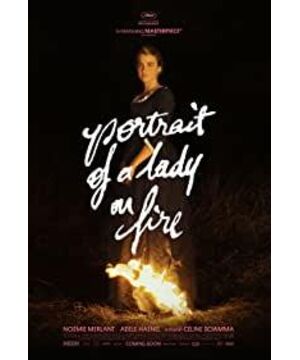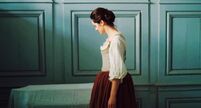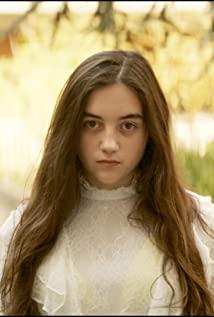When I first brushed it, the most impressive thing was that I rarely saw such a lesbian movie that does not consume lesbians. I always think that the male gaze is symbiosis with the art of film, but I don’t know that this gaze can be transformed into a female with such precision, and it becomes a burning gaze between women and women. The artist's initial "seeing" was utilitarian, but her gaze attracted the lady's "seeing". Since then, the undercurrents gradually raged under every calm stare. When you "watched" the climax, it was a heat wave from the campfire. It was you who were caught in the dark by my gaze. Only you can burn a bright light in my eyes. Where is the spark from the bonfire on the burning skirt? My eyes are so hot that you fall to the ground helplessly. Not only did I see you, I also understood you, not only did I understand you, but I could also copy endlessly what I saw you, and a thousand you were deduced in my heart. A woman is such a delicate plaything in the gaze of a man, but it is so thrilling in the gaze of a woman.
Another point is that the whole movie has sold a LGBT miserable sentence from beginning to end without crying and crying, and there is no miserable saying that is similar to: "I love this person, and it has nothing to do with gender." When the lady wanted to kiss the painter for the first time, she asked if you ever loved it? Instead of having you loved a woman? The processing of lines in gay movies is so exciting. A gay movie that can resonate emotionally is mostly de-gay, and it can change the identity of a painter to a poor boy of any class. The only difference may be the speed of emotional development. After all, the poor boy might have shouted his name and sang on the balcony the next night, but it was different when he sang on the two women. The ambiguous feelings between the two were laid out in the first half an hour, and it wasn't until the bonfire that the sense of ritual like a stage play began to burst. It’s wonderful that the desire between women and women to talk, refuse and welcome, those eyes that I dodge when you look at me, every time I get close I can feel the timely convergence of each other’s breathing, the kind of showing emotions to each other Understanding in a unique way is more moving than a real kiss. When I was kissing, I looked at the time specially, and the two-hour movie came to this point, exactly one and a half hours. It's no wonder that the straight man beside him fell into a coma for several times in the first one and a half hours without background music and chattering (but it's also wonderful that he was soberly watching the last half an hour and tweeted praise).
When it comes to femininity, I have to add more. The ambition of this movie is not just a gay movie, but it is also quite a feminist movie. A long review has also mentioned that there are no men in this movie, and the audience can only see one female character after another. But for every female character in this group, there is a man with a spirit behind him. The Milanese gentleman the lady is going to marry, the painter's slightly famous father, and the man who made the maid pregnant. They did not appear from beginning to end, but they were holding back their destiny and controlling the development of the plot. However, under limited conditions, they are doing their best to dance in shackles. The young lady tried love before becoming a tool-like woman; the painter was not allowed to touch the male body structure, so she quietly studied and participated in the exhibition under her father's name; the maid could not control whether she was pregnant, but she could decide whether to give birth. When the lady laid a mat in front of the fire and ordered the maid to lie on it, and the two reproduced the abortion scene, the painter's brushes no longer recorded two specific women, but sketched out an epic of women.
Although the above-mentioned impressions have been reconfirmed in the second brush, this time it was more captured by Wen Tun's output of love. It is a new bottle of new wine that uses Greek mythology, but this new wine is excellently brewed. In order to rescue his beloved wife Eurydic from the underworld, Orpheus broke into the underworld. After finally impressed by the underworld, Orpheus agreed to let him take his wife away. It's just a little bit, not to look back, otherwise the wife will be left in the underworld forever. At the moment when he was about to leave the underworld, Orpheus couldn't help but want to confirm whether his wife was really behind him, so he turned his head and Eurydice fell back into the underworld and sank into the endless darkness.
After hearing this story, the maid was very angry and said it was unreasonable. Why couldn't she bear it for a moment, this stinky man. Although the painter understood his intention, he said that unless he didn't want to hold it back, perhaps Orpheus just wanted to turn his head and freeze everything at a separate moment, leaving only memories. But he added that this is the poet's choice, not the lover's. The lady read it again and said, maybe Eurydice asked. Eurydice said, please turn around. Orpheus then turned around, and they saw each other for the last time, and that glance was a memory of each other, a beautiful past that can be infinitely reproduced if it can't be taken away.
This story-telling scene is the core topic of the whole film's discussion of love, and the three have a clear attitude towards feelings. The maid’s chaos is destined to be the most smoky eating and drinking men and women. The painter has a glimpse of the true face of love but does not want to face it. The young lady has never loved, but she knows how to love. In general, what we claim to be love is just to hold and claim in the name of love. The painter has a little bit of a young lady, so he has more greed, trying to ask the young lady to change, hoping that she will fight for this love and change the trajectory of her destiny to stay with her. The lady said that you have never tried to stand on my side and think, whether it is painting or love, you are only for yourself. When I asked for it, it was not what I wanted at first.
Love often becomes ugly in this way. From "you jump, I jump" to "I would rather die than face you". Jack's life is bound to be like this after being rescued. The fairy tale must be broken by the creator himself, telling you that love is not dependent on life and death, but life and death. We have seen too many love fairy tales, so that whenever we encounter emotional setbacks, we will blame ourselves and the other party for all, but we don't realize that the conventional definition of love is absurd. The so-called endurance and running-in are mostly spent, why bother to grab the last drop and leave a place of bagasse.
There is also an image related to love. Except for the most conspicuous fire, the most visible throughout the film is clearly water, which is the water that never sees blue, gray misty haze. The young lady said that she had never been in the water before and wondered if she could swim. When the artist stated that she was leaving, she said that she was going into the water. Decisively untied the skirt and went to the sea, drowning and shivering, is it watery? Hard to say, maybe it floated for a while. Painting is also an echo. When the painting is finished, I will know the moment after painting. This is when love does not start, but at the moment of possession and end, you must know it. But think about it afterwards, will you really love it? can not say it clearly.
The young lady said at the last moment, turning around. This is a ritual, and a proper farewell is far more important than a confession, for the purpose of breaking the arm of a strong man who loves eternal love. Even if goodbye, there will be no chance for them to meet each other again. The symphony was full of enthusiasm, and the lady led the painter to relief while being watched.
Love, please turn your head back, the moment you can't keep it is eternity, this is the most appropriate interpretation of love. Forever, time will end, but everyone doesn't believe it.
View more about Portrait of a Lady on Fire reviews











